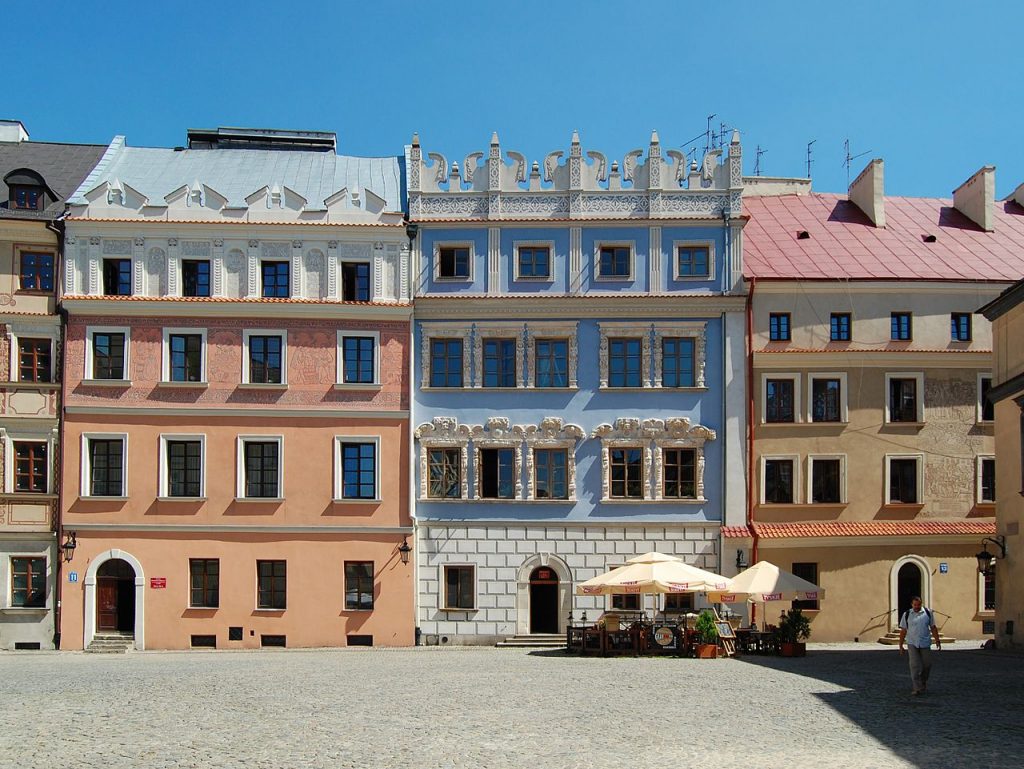An important city in eastern Poland, Lublin has preserved a very picturesque old quarter that offers a glimpse of what life was like here in the seventeenth century, with a city hall in the middle of the rynek, a Dominican church, fortifications, and various city gates. Lublin also features a castle surrounded by a park plucked straight out of a tale from The Thousand and One Nights. The castle and its park are accessible from Zamkowa Street.

Large numbers of Jews began settling in Lublin in the fourteenth century, first in the Kazimierz Zydowski district, later near the castle. The Grodzka Gate was called Brama Zydowska (Jewish Gate). The sixteenth and seventeenth centuries were the high point of Lublin’s Jewish community: a Hebrew press was founded in 1547, followed by a second one in 1578; the town also featured a renowned talmudic school directed by major figures of the era -Solomon Luria, Mordecaï Jaffe, and Meir ben Gedaliah (It is also where Moses Isserles completed his studies). In the nineteenth century, Lublin became a major center for Hasidism, centered around the tsadik Yaakov Yitshak, known as the Seer of Lublin and a disciple of the Great Maggid and Elimelech of Lyzhensk.
When war was declared in 1939, 45,000 Jews lived in Lublin. They had seven synagogues, two mikva’ot, a hospital, a library, and schools. The ghetto was created in March 1941, and in March 1942, 30,000 Jews were deported and exterminated in the Belzec camp, while the rest were executed on the spot or taken to the camp in Maidanek.
The Jewish city
First, absorb the atmosphere and take the pulse of this neighborhood with its rynek, its city gates, Grodzka Street, Po Farzu Square, and the old Jewish gate. To the right, heading down Grodzka Street, was located the Jewish community’s retirement home (dom starców), marked by a commemorative plaque.

The little streets running off Grodzka Street are the former Jewish alleys, often still neglected, which lead to Lubartowska Street and Ofiar getta (Victims of the Ghetto) Square, with a monument in memory of the murdered Jews of Lublin. The synagogue was located at 10 Lubartowska Street, transformed today into an isba (room) in the memory of Lublin’s Jews : a small museum with photographs and historical documents on display. At number 83 of the same street once stood the rabbinical school, Yeshivat Khachmei Lublin, today part of the Academy of Medicine, and, next door, the Jewish hospital. In 2004, these buildings were handed back to the Jewish community and today house a synagogue , mikvah and the Jewish community.
The No Name Theatre , set up in 1990 by people wishing to share Lublin’s historical heritage, holds the archives of the demolished Jewish ghetto houses, displays period photographs and passes on the history of the Shoah through cultural activities. The Lubliner Festival of Jewish Culture is held every year over two days at the end of August.
The two Jewish cemeteries are worth visiting, especially that on Kalinowszczyna Street , built in the sixteenth century. A number of personalities are buried here: Rabbi Shalom Shakna, founder of the Talmudic school, who died in 1558; Talmud scholar Yehuda Leybush ben Meir Ashkenasi, who died in 1597; Rabbi Itzhak Aizyk Segal, who died in 1735; and above all, the tsadik Yaakov Yitshak, who died in 1815 and whose grave is covered with small stones of homage. The other cemetery, the one on Walecznych Street , dates from the nineteenth century. It is large and contains beautiful graves as well.
The Maidanek camp
You cannot leave Lublin without stopping at the Maidanek camp , which is located today in a suburb of the city. It is easily visible from the road facing Chelm. The activities of the camp could be easily seen or guessed at from the city. A careful tour of Maidanek, where the barbed wire, barracks, gas chambers, and crematorium have all been preserved, is particularly moving and impressive, comparable to that of Auschwitz (with fewer tourists, however).